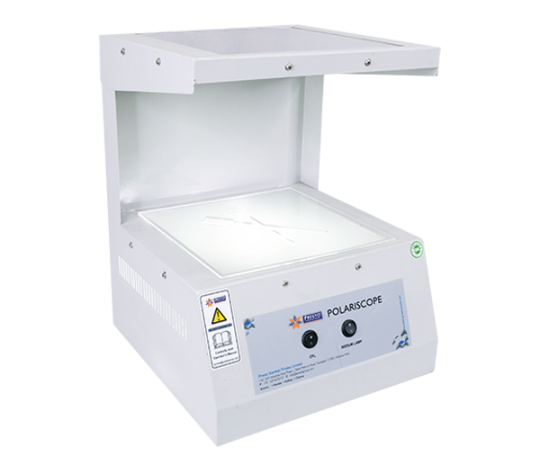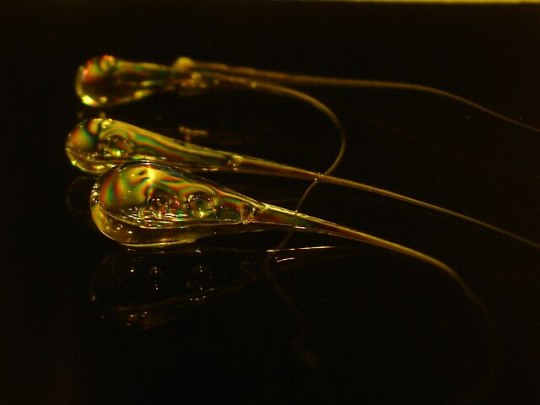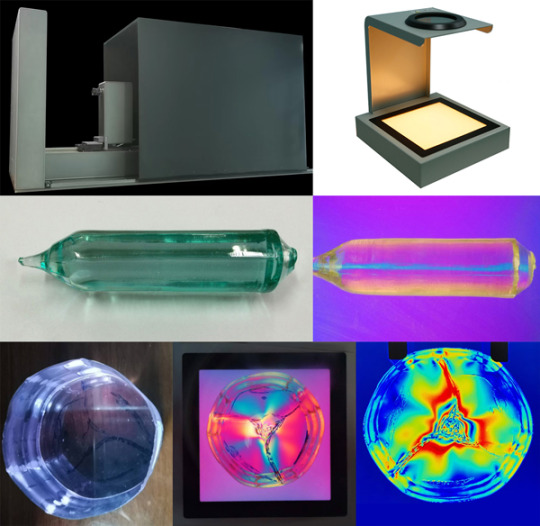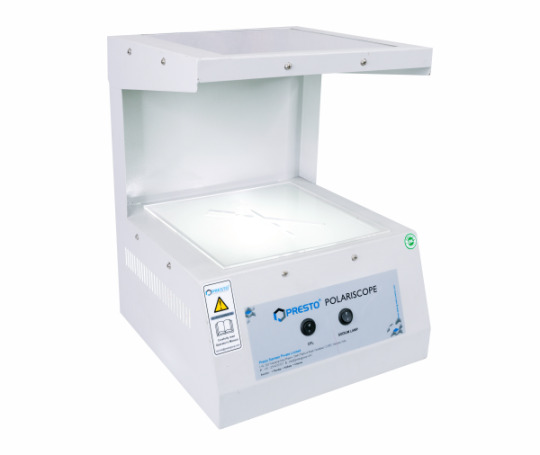#polariscope
Explore tagged Tumblr posts
Text

Polariscope | Perfect Group
The Polariscope is a modern instrument from Perfect Group for stress analysis in transparent materials. Our Polariscope ensures product reliability and quality by using innovative optics to identify and see internal tensions. It correctly detects stress patterns using exact polarization techniques, which is essential for determining the strength and durability of materials. It serves a variety of industries, such as glass manufacturing, plastics, and quality control, and is built to be both versatile and dependable. Put your trust in Perfect Group's Polariscope for excellent product assurance and detailed stress analysis.
0 notes
Text
Know About Polariscope in Pet Industry: Testing-Instruments
A polariscope is a testing instrument that is used to detect defects and stresses in PET preforms, which are the raw materials for making PET bottles and containers. PET preforms are transparent plastic tubes that are heated and blown into various shapes and sizes. However, during the manufacturing process, PET preforms may develop internal strains or deformities that can affect the quality and performance of the final products. A polariscope works by using two polarized lenses and a light source to examine the PET preforms.
The polarized lenses filter the light and create a dark background. When a PET preform is placed between the lenses, any defect or stress in the material will refract the light and create a colorful pattern. By observing the pattern, the user can identify the type and location of the defect or stress in the PET preform. A polariscope can also measure the angle and intensity of the birefringence, which is the difference in the refractive index of the material along different directions.
If you are looking for a reliable and high-quality Polariscope Strain Viewer in India, you might want to check out the products from Presto Group, a leading manufacturer and supplier of laboratory testing instruments and equipment across India. You can find more information about the Polariscope and other products from Presto Group. You can contact Testing-Instruments for a quote or more information by visiting their website or calling them at +91–9210903903.
#polariscope#polariscope price#polariscope strain viewer#portable spectrometer#portable spectrophotometer
0 notes
Text
Buy the best quality Presto’s polariscope strain viewer

Presto Stantest offers a high quality of polariscope that helps to determine the quality of the preforms and to identify the defects in the Preforms. A polariscope strain viewer testing strategy helps to produce high quality PET bottles and products. The testing equipment offers highly reliable and precise test results. The PET containers that are manufactured in PET & Preform industries are blooming in the packaging industries, especially in pharmaceutical industries and food & beverage industries to pack medicines. The PET containers that are manufactured in PET & Preform industries are blooming in the packaging industries, especially in pharmaceutical industries and food & beverage industries to pack medicines, syrups, chemicals, drugs, food items and beverages which make the preforms carefully efficient and that offers the wide range of PET containers.
0 notes
Text

Polariscope | Perfectgroupindia
With the help of the wonderful Polariscope equipment, we may examine and assess the internal stresses that are present in transparent or translucent materials. An in-depth discussion of the Polariscope idea, stress analysis applications, and how it influences material behavior are provided in this article. There are interference patterns seen through the analyzer as a result of the polarisation direction rotating variably as it passes through the material due to the various regions' varied refractive indices.
2 notes
·
View notes
Text
#1219 What is Prince Rupert’s drop?


What is Prince Rupert’s drop? Prince Rupert’s drop is a small, tadpole-shaped glass bead that is incredibly strong but incredibly fragile. Prince Rupert’s drops have been around for a long time and there is some thought that they were first discovered by Roman glassmakers two thousand years ago. They were first brought to Great Britain in 1660 by Prince Rupert of the Rhine, who was an English-German noble, soldier, and scientist. He gave them to King Charles II, who in turn gave them to the Royal Society to be studied. They became known as Prince Rupert’s drops and the name has stuck. King Charles II was very interested in science and he was the patron of the Royal Society, which had only been started a few years earlier. Prince Rupert’s drops have very special properties. They are made by dripping molten glass into cold water and they set in a tadpole shape, with a bulbous head and a longish tail. The head of the tadpole is incredibly strong and can withstand hammer blows and bullets. They have been tested to be able to withstand a force of 664,300 Newtons, which is 67,740 kg. Yet, despite this awesome strength for something so small, if you even slightly chip the tail of the tadpole, the whole Prince Rupert’s drop will just explode and become a powder, instantly. To make a Prince Rupert’s drop, you have to have a ball of molten glass and glass melts at between 1,400 to 1,600 ℃, so that’s pretty hot. When you have the molten glass ready, let it drip into a bucket of cold water. The cold water will absorb the heat energy from the molten glass as soon as they come in contact and the outside of the molten glass drop will cool and harden pretty quickly. The heat inside the drop will take longer to be absorbed and the very center will be the last part to harden. You will be left with a solid glass tadpole drop shape which you can then hit with a hammer. Just be careful of the tail. The scientists of the Royal Society had several theories about why the glass was so strong and yet so brittle at the same time, but they were unable to come up with the complete answer. In fact, that answer has only been discovered in the last few years, and that is only because of modern technology. It took a high-speed camera that could shoot at a million frames a second and something called a transmission polariscope, which can measure optical radiation. The high-speed camera that could take a million frames a second allowed scientists to see what was happening when the tail was chipped. Cracks appear at the point where the tail was damaged and they rapidly spread, forming more and more cracks, until the whole piece of glass is reduced to powder. It took a high-speed camera to see this because the cracks promulgate at a speed of roughly 1,800 meters per second, which is about 6,500 km/h. So, why is a Prince Rupert’s drop so strong, yet it explodes if you chip its tail? The reason for both of these things are the same. When the molten glass is lowered into the cold water, the heat energy held in the molecules passes into the water because heat energy always goes from a hot place to a cold place. When the molecules have heat energy, they move more and they take up more space. When they lose this energy, they stop moving and they contract, taking up less space. If the Prince Rupert’s drop was cooled from the inside out, the center would contact and then the succeeding layers would contract until it was all slightly smaller. However, it cools from the outside first. The outside layer very quickly cools and becomes hard. The inside layers start to cool and contract, and they pull on the outside layer, but it has already solidified and doesn’t move. Each successive layer that cools, pulls on the already solid layer above it, and all they do is pull it down, putting it under tension. This makes each layer much stronger than if it wasn’t being pulled down. It is similar to an arch bridge that gets stronger when it has weight on it because the weight pushes it down and the forces are distributed along the curve of the arch. This high tension makes the Prince Rupert’s drop very strong, but it also makes it a tensile stress time bomb waiting to go off. All of the molecules are pulling on the ones in front of them, which gives it an enormous amount of potential energy. Any break in the chain of molecules will release all of that energy, which will gradually increase, like a mass of dominos after the first one is knocked over. The reason why a chip in the tail is where this energy starts to get released is because it is much thinner there and there is not so much strength. It is much easier to break the chain and release the energy, which races forwards at several times the speed of sound, leaving nothing but powder. And this is what I learned today. Read these next: - #768 What is the Hudson Bay Company? - #1163 What is a tadpole shrimp? - #1047 What are tails for? - #82 Why is skin waterproof? - #456 When did people start using glass for windows? Sources https://www.ck12.org/flexi/chemistry/heating-and-cooling-curves/what-is-the-temperature-at-which-glass-melts https://royalsocietypublishing.org/doi/pdf/10.1098/rsnr.1986.0001 https://www.youtube.com/watch?v=xe-f4gokRBs https://en.wikipedia.org/wiki/Prince_Rupert_of_the_Rhine https://en.wikipedia.org/wiki/Prince_Ruperts_drop https://engineering.purdue.edu/IE/news/2022/chandrasekar-coe-blog Image By Mg3kc at English Wikipedia - Own work, Public Domain, https://commons.wikimedia.org/w/index.php?curid=5555208 Read the full article
0 notes
Text
How Gemstones can be distinguished from one another

Gemstones can be distinguished from one another based on their physical, optical, and chemical properties. Here's a detailed breakdown of how they differ:
Physical Characteristics Color: The primary way gemstones are differentiated. For example: Rubies are red due to chromium, while sapphires are blue due to iron and titanium. Some gems, like tourmaline, come in multiple colors. Hardness: Measured on the Mohs scale. Diamonds (10) are harder than sapphires (9) and quartz (7). Specific Gravity (Density): Heavier stones like zircon can be distinguished from lighter ones like topaz, even if they appear similar.
Optical Properties Refractive Index (RI): The way light bends when passing through a gem. Each gemstone has a unique RI, measured with a refractometer.
Diamond: RI ~ 2.42 Emerald: RI ~ 1.57–1.60 Optical Phenomena:
Asterism: Star-like reflection in star sapphires or rubies. Chatoyancy: "Cat's eye" effect in chrysoberyl. Adularescence: Glow seen in moonstone. Iridescence: Rainbow-like effect in opals. Pleochroism: Certain gemstones, like alexandrite or tanzanite, appear different colors from different angles.
Chemical Composition Gemstones have distinct chemical formulas: Diamonds are pure carbon (C). Rubies and sapphires are varieties of corundum (Al₂O₃) with different trace elements. Emerald is a variety of beryl (Be₃Al₂Si₆O₁₈) with chromium or vanadium. Testing for chemical composition using tools like a spectroscope or X-ray fluorescence (XRF) can identify gemstones.
Crystal Structure Gemstones have unique crystal systems (e.g., cubic, hexagonal, triclinic). Diamonds: Cubic system. Quartz: Hexagonal system. Crystal habit and growth patterns can help differentiate similar stones.
Inclusions and Impurities Inclusions (internal imperfections) act as "fingerprints" for gemstones. Emeralds often have "jardin" (garden-like) inclusions. Diamonds may show tiny carbon specks. These inclusions can be studied under a microscope.
Fluorescence Some gemstones emit light under ultraviolet (UV) light. Diamonds often fluoresce blue. Rubies fluoresce red due to chromium.
Use of Advanced Tools Refractometer: Measures refractive index. Spectroscope: Analyzes light absorption patterns. Gemstone Tester Devices: Identify stones based on thermal or electrical conductivity. Microscope: Examines inclusions and growth patterns. Polariscope: Determines whether a stone is singly or doubly refractive.
Treatments and Synthetics Synthetic gemstones can mimic natural ones but have distinctive growth patterns or lack natural inclusions. Treatments like heating, dyeing, or coating can alter a gemstone's appearance but leave traces detectable by gemologists. By combining these techniques, professionals can accurately identify and distinguish gemstones. For reliable testing, consult certified gemologists or laboratories like GIA or IGI.
0 notes
Text

Reasons Why Polariscope Strain Viewer is Essential in 2024
In 2024, the Polariscope Strain Viewer remains essential for its critical role in analyzing material quality and integrity, especially in industries like glass manufacturing. It aids in detecting defects early, ensuring product durability and reliability, particularly in advanced material applications such as aerospace and electronics. Additionally, it contributes to safety and efficiency by optimizing material usage and minimizing waste during production processes.
0 notes
Text
PTC Optical Instrument brings new solution to Laser Photonics
The 18th Laser World Photonics China successfully concluded at the Shanghai New International Expo Center. During this exhibition, local Chinese and international exhibitors displayed many advanced core solutions in five fields: Laser Intelligent Manufacturing, Laser and Optoelectronics, Inspection and Quality Control, Optics and Optical Manufacturing, and Infrared Technology and Applications.

Laser power continues to increase, high-power lasers are gradually popularized, and the ultrafast laser market is expanding rapidly. As the core of solid lasers, laser crystals have important and extensive applications in military and civilian fields such as laser precision processing, laser weapons, photoelectric countermeasures, laser medical treatment and many others.
Laser crystals have the characteristics of high thermal conductivity and optical anisotropy. Cd:YAG is a new substrate and window material for ultraviolet and infrared optical devices. During the growth process of YAG single crystal, due to the temperature gradient between the crystal and the melt, a certain amount of residual stress will still remain inside the crystal even after a certain annealing process.
In order to observe and analyze the stress of crystals more intuitively, PTC Optical Instrument has developed a series of Polariscopes. These Polariscopes help technicians to quickly observe stress distribution , measure optical retardation in crystal products.


0 notes
Video
instagram
Colombia Blue Smoke / Mist Quartz Cross Sections, with Trapiche patterns under a Polariscope! Taste the rainbows! Look at all the patterns! What pattern do you see? 👀 - - - #colombianquartz #bluesmoke #bluemist #quartz #crosssection #quartzcrystal #colombianquartzcrystal #trapiche #hexagon #polariscope #rainbow #rainbows #rainbowcrystal #rainbowcrystals #crystalrainbow #crystalcommunity #crystalenergy #crystalsofinstagram #crystalsofig #crystalsofinsta #crystalporn #wirewrapping #wirewrap #phenomenal #crystalmagic #overtherainbow #cabochons #crystalhealing #shareyourheart #handsofspirit https://www.instagram.com/p/CNbTtJIBd1v/?igshid=10tanr1xkr1xo
#colombianquartz#bluesmoke#bluemist#quartz#crosssection#quartzcrystal#colombianquartzcrystal#trapiche#hexagon#polariscope#rainbow#rainbows#rainbowcrystal#rainbowcrystals#crystalrainbow#crystalcommunity#crystalenergy#crystalsofinstagram#crystalsofig#crystalsofinsta#crystalporn#wirewrapping#wirewrap#phenomenal#crystalmagic#overtherainbow#cabochons#crystalhealing#shareyourheart#handsofspirit
1 note
·
View note
Text
Polariscope is a unique instrument that can be used to view the night sky. This device is made up of two lenses that rotates to create an image. This instrument is great for astronomers because it can help them study distant objects and understand the history of our universe. Best Polariscope by Perfect group India
1 note
·
View note
Text

Polariscope | Perfect Group
Presenting the perfect example of optical instrument accuracy, the Polariscope from Perfect Group. Our Polariscope, which is designed to reveal stress patterns in materials with unmatched accuracy, provides invaluable insights for a variety of industries, including diamonds and manufacturing. Its finely crafted design guarantees dependable operation and long-lasting quality. For innovative solutions that redefine perfection, rely on Perfect Group. With the Polariscope, your primary resource for accurate analysis, you can uncover the hidden dynamics in your materials and raise the bar.
0 notes
Text
Get best quality polariscope strain viewer at best price in India

Presto’s polariscope is a strain viewer for glass and PET Preform that is provided with a metallic base and is painted in autumn gray and blue color. Along with that, it is also provided with zinc/chrome plating which provides the equipment, excellent resistance to corrosion. A user manual and a calibration certificate are provided with the instrument, which is traceable to Labs approved by NABL. With these features and specifications, Presto offers a robust and precise solution to check the quality of the PET preforms used in the plastic industry and that also at very competitive prices. Presto presents polariscope strain viewer, a high-quality testing instrument that is used for checking the quality of PET preforms. It works on the principle that any change in the refractive index of a material indicates strain in that material, which affects the quality of the material. You can get the best polariscope pricein India.
0 notes
Text
Test the flaws present in PET preforms with a Polariscope strain viewer

PET preforms are made from a polyester material that is strong and lightweight. However, during the manufacturing process, the preforms can be damaged or deformed. The most common way to test the strength of PET performs is by using a PolariscopeStrain Viewer. Presto is a leading Polariscope strain viewer manufacturer and designs this quality testing instrument as per industry standards. Testing for strains ensures that only performs with optimal transparency are used in production. Thus, to test the flaws present in the materials, it is important for PET manufacturers to make use of a Polariscope strain viewer. This is one of the high-quality lab testing instruments that is used to test the strains and stresses present in PET bottles and ensures that quality material will be delivered.
0 notes
Text
Polariscope | Perfect Group India
Polariscope is an optical device used to view objects that are located at a distance. They were invented in the early 1800s and remained an important instrument for astronomers until the 20th century. The optical principles used were similar to the pinhole camera; however, a polariscope had the advantage that it did not have to include a lens or mirror to focus the light onto the screen. This made it much cheaper to produce than a telescope and was smaller and easier to use than a camera obscura.
1 note
·
View note
Text

Polariscope | Perfectgroupindia
Polariscope is a qualitative tool that shows stress patterns in transparent or translucent things by using polarised light. Polariscopes (also known as strain viewers) come in a variety of standard versions from Strainoptics, ranging from small, portable units to big, modular devices that may be free-standing, mounted on a wall, placed on a tabletop, or even used on a production line. The polariscope relies on the optical phenomenon known as birefringence to function. When examined in polarised light, this phenomenon causes a strained transparent or translucent material, such glass or plastic, to display a distinctive range of colours.
1 note
·
View note
